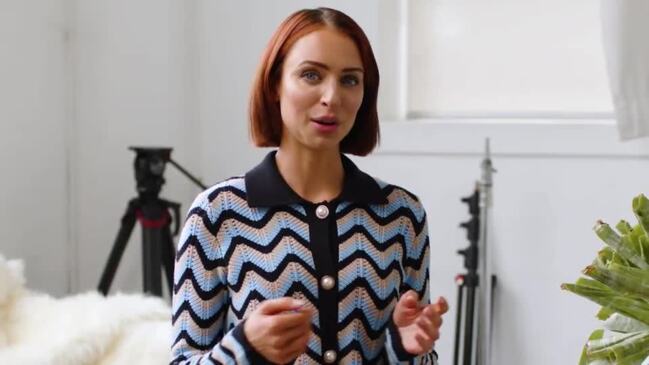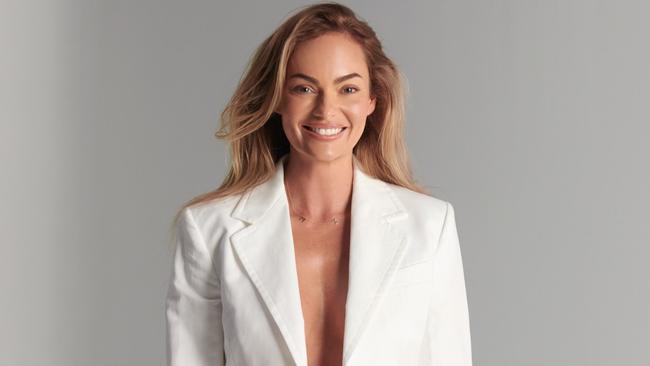Emily Skye: smart, successful and just diagnosed with ADHD
She's on the road to self-acceptance

Lifestyle
Don't miss out on the headlines from Lifestyle. Followed categories will be added to My News.
In this article
Inside Emily Skye's adult ADHD diagnosis
How the fitness supernova is learning to love herself
Signs of undetected ADHD
After learning she had adult ADHD at 39, fitness guru, Emily Skye, is finally getting to know herself. But she’s just one of many high-profile, highly successful women who’ve recently shared a later-life diagnosis. Could you be one of them? And what does it mean if you are?
To the outside world, including her 15 million social media followers, Emily Skye appears to have it all. Gold Coast-based Skye runs a thriving fitness app, Emily Skye FIT, along with cult beauty brand, James Cosmetics.
She has two gorgeous children with her ex-commando fiancé, Declan Redmond, who proposed with a dazzling solitaire rock in January, on a beach, amid scattered roses, while their two kids, six-year-old Mia and three-year-old Izaac, looked on. The former model and make-up artist is so successful she’s made several appearances on the Australian Financial Review’s Young Rich list. In short, her life is like a vision board.
But Skye has never seen herself as picture-perfect. For most of these years she felt strange, the odd one out. She never fit in. A super-sensitive overthinker with an intense fear of rejection, Skye thought that she was unintelligent, incompetent and unlovable.

“I never belonged anywhere,” the business woman, fitness expert and qualified personal trainer admits. “We all need feelings of belonging and being loved and accepted. So, I did whatever I could to get those feelings.” Ergo, Skye became an expert mimic from a young age. “I subconsciously studied the way people behaved; their mannerisms, what they talked about, how they dressed.
I didn’t know how to act socially, or what the right thing to do was. Other people always seemed to just pick it up.”
In high school on the Central Coast north of Sydney, Skye struggled to concentrate on subjects she wasn’t interested in, such as maths, despite being bright. “My mind would go elsewhere. I’d doodle all over my page or think about what I was going to do after school – anything to make it look like I was focused, like ‘the good girl’, but I didn’t hear a word the teacher said.
“I felt completely broken and abnormal for not being able to retain information. Even later in board meetings, I’d be off with the fairies.” If a topic did pique Skye’s interest, such as art, English, drama and, eventually, fitness, she could be hyper-focused.

When Skye was diagnosed with attention deficit hyperactivity disorder (ADHD) earlier this year, at age 39, her life suddenly made sense. She realised her perceived shortcomings were not her fault. “My brain is just wired differently.” And, as an increasing number of news headlines and social media posts confirm, she’s in good company, with high-profile public figures, including Em Rusciano, Abbie Chatfield, Mia Freedman, Lily Allen, Greta Gerwig and Barry Keoghan, all publicly revealing adult diagnoses.
Writer-slash-singer-slash-comedian Rusciano delivered a powerful speech to the National Press Club of Australia in 2022 about her ADHD diagnosis at 42, which “profoundly changed my core beliefs about myself… and triggered enormous grief”, she said. “I felt a deep sadness for that precocious, curious and chaotic 10-year-old girl who desperately wanted to get things right; the girl who tried hard all of the time.”
It took Mia Freedman, the co-founder of Australia’s largest independent women’s media company, Mamamia, about a year to go public with her diagnosis, at the age of 49.
“I am a very basic bitch because lately it seems like you can’t open Instagram without a woman in her 30s, 40s or 50s announcing she has ADHD,” Freedman wrote jokingly on Mamamia in 2022. “Today I’m adding my name to that list.” She went on to say it’s a growing movement, but considering a diagnosis is notoriously hard to get, it’s certainly not a fad. Ask any expert or patient; you can’t ‘fake’ this issue that influential voices around the world are now shining a light on, starting a national conversation that is long overdue.

Unscrambling ADHD
But first, some background on this hugely important health issue. ADHD is a largely inherited, neurodevelopmental condition that starts in childhood, with symptoms presenting in three ways: inattentive, hyperactive-impulsive and combination. Someone with predominantly inattentive symptoms is easily distracted, struggles to organise themselves and has difficulty focusing on tasks they find boring. For example, they may forget things, lose things, constantly run late or procrastinate.
Someone with predominantly hyperactive-impulsive symptoms finds it hard to be still and they may fidget, talk or interrupt a lot. They can be prone to risk-taking behaviours or react quickly without thinking. Some people have a combination of both inattentive and hyperactive-impulsive symptoms.
Of course, everyone loses their keys or finishes other people’s sentences occasionally. Getting side-tracked by pings from your phone is de rigueur. Daydreaming during a work meeting? We’ve all done it. Does everyone have ADHD, then? No, says Dr Maddi Derrick, a Hobart-based clinical psychologist who, coincidentally, does have it. She insists symptoms are “significantly impairing” and are consistent from childhood – in all settings, not just at work, or just at school, or just in relationships.

This is not to say that people with ADHD can’t overcome these obstacles or become wildly successful, as per Skye… and Rusciano and Freedman et al. Quite the opposite. ADHD can, in some cases, be a superpower. Just ask basketball legend, Michael Jordan, who was diagnosed with ADHD as a child, but since said it helped him stay hyper-focused on the court and fuelled his iconic performances. Billionaire Richard Branson, whose diagnosis happened in adulthood, is adamant it gave him the ability to think outside the box and embrace risks.
In terms of prevalence, ADHD affects six to 10 per cent of kids and teens, and two to six per cent of adults. Many experts believe it has been underdiagnosed in Australia, especially among women; however, rates are on the rise. The number of total prescriptions that were issued for ADHD medications in Australia more than doubled between 2018 and 2022, from 1.36 million scripts to 3.17 million. However, we don’t know how many were written for adults versus kids (or men versus women), and not all people who are diagnosed will seek medication.
Most of Derrick’s new clients are women. “It’s important to note, they’re not going along fine and then suddenly think they have it,” she explains. “They’ve typically struggled with their mental health their whole life, maybe having been treated for anxiety and depression symptoms that were outcomes of unidentified ADHD.”

Keeping up appearances
Perfectionism, explains Derrick, can be a hallmark of undetected ADHD.
“A female can appear to be high functioning in a professional job, but might spend three hours at home each night working to catch up. Some women [with ADHD] desperately want to make everything perfect and to always please everyone, because if they don’t, they’ll be uncovered as an ‘imposter’.”
“I can act confident; it doesn’t mean I’m feeling it,” says Skye, who’s collaborated with the Kardashians and major global brands including Good American. “All my life, I’ve put a facade on, especially online. I’m still me, but I created this avatar, a protective armour.”
Because females are often adept at ‘masking’ ADHD symptoms, even in childhood, the condition is twice as likely to be picked up in boys aged four to 11 years than in girls of the same age. This gap widens among adolescents aged 12 to 17, with almost 10 per cent of boys diagnosed, compared with just 2.7 per cent of girls. While boys with ADHD might disrupt the class or climb the walls at home, girls are often better at doing what’s expected of them.

“It will start to show in the early school years, at a time when girls, on average, are maturing socially and emotionally ahead of boys,” explains Derrick. “So, boys might still be oblivious to what others, including the teacher, think of them. Meanwhile, developmentally, the average girl will start to focus on how others perceive them, and how to please the teacher.”
“Boys tend to impact other people,” concurs Craig Woolf, 54, who was diagnosed as a 15-year-old and is now an ADHD coach. “They may talk out in class and be active, rough or boisterous. I was certainly told to shut up a lot in my household.” While Woolf’s ADHD was detected in adolescence, nothing was done about it until he was 30, when his symptoms became more obvious through living with his wife. “And because she’s very capable, she was always quick to remind me to take my meds.”
Breakthrough, not a breakdown
Skye always suspected she had ADHD but didn’t seek a diagnosis until the proverbial wheels fell off. She figured it was that… or perimenopause. “I had moments of being in the house with the kids and nothing in particular would happen, but I’d start bawling,” she recalls. “Facing the day became overwhelming for me. I wasn’t functioning and knew something was not right in my brain. I thought, ‘I’ve got to do something about this.’”
Skye saw her GP and got referrals to several psychiatrists so she could join waitlists – “It can take 18 months to see someone,” she laments – and, luckily, got a cancellation spot within a few days. Her ensuing ADHD diagnosis brought immense relief.
“People said to me, ‘You’re 39, why bother getting diagnosed now? You don’t want a label.’ But, for me, the ‘label’ has allowed me to identify what it is and how to manage it better.” It’s also helping Skye reframe her brain, build her confidence and see the positives in her neurodiversity. “I’m learning to love myself,” she says.

“It takes a lot to reprogram those thought patterns and beliefs that you have about yourself. It’s all just been a certain way for so long.”
Symptoms can be managed with cognitive-behavioural interventions, medication and/or lifestyle changes, but, ultimately, how you choose to frame a diagnosis can be key. “It’s the acceptance and understanding of ADHD that enables a person to maximise their strengths, get help where needed and put themselves in an optimal environment where they can thrive,” says Dr Tamara May, a senior research fellow at Monash University and a clinical psychologist who works with adults with ADHD. “Ask yourself, ‘What am I good at? What tasks do I find easier?’ Then from there, try to find or set up an environment that will play to those strengths.”
Many roles are almost tailor-made for people with ADHD, assert May and Derrick. Fast-flowing thoughts and limitless ideas, plus a penchant for risk, can lead to game-changing innovation and entrepreneurship. Research strongly suggests people who have ADHD are generally more creative and better at problem-solving.
They often shine in a crisis, too, where quick thinking and being used to lots of stimuli help them keep their cool. “In an emergency, when a million things are going on at once, I don’t get overloaded by it,” adds Woolf. “I’m already overloaded by everything.”
“We see concentrations of ADHD among people [who work in] emergency services – police, ambos, defence forces and in hospital emergency rooms,” confirms Derrick.
Skye says she unknowingly tapped into her ADHD traits over the years, especially when building her businesses. “You can be so focused, obsessive and creative,” she says. “If you’re interested in something, you can learn so much about it. Provided that you seek help, learn how to support yourself and stay on top of your health consistently, you are unstoppable.”

Skye is finally on the road to self-acceptance and self-compassion. The fitness doyenne is grateful for her diagnosis, as well as her family, friends and especially Redmond, “who has stood by my side for 14 years, despite the challenges of living with me,” Skye told her loyal Instagram followers in February. “It still surprises me that he wants to marry me!”
What would she say to someone who has been newly diagnosed with ADHD? “Welcome to the club. You belong. You’re my people.”
Think you or a loved one may have ADHD? Here’s how to get help and support.
It’s totally normal to be distracted, forgetful, restless, even impulsive from time to time, especially if you’re flat-out busy or tired. But if you have ADHD, its symptoms are ongoing, heavily impact your performance and relationships, and have been there since childhood. Here’s how to seek help and/or a diagnosis.
The first step in what may inevitably be a long journey: speak to your GP who, if aligned, will refer you to a specialist psychologist or psychiatrist.
Psychologists can only diagnose ADHD after a very detailed assessment, then provide practical mindset and lifestyle tools to manage symptoms.
A psychiatrist can also diagnose ADHD, but only they (or paediatricians, for younger patients) can prescribe initial medication in Australia. Note: there are very few ADHD specialists in Australia and the waiting lists for psychiatrists are notoriously long.
To speed up the process, ask the psych’s office to send all the diagnostic forms, record requests and referrals they’d give at your first meeting the minute you’re on their waiting list. These often take time and other appointments to gather and will be a godsend if you score an earlier cancellation slot. It also means you can discuss diagnosis on visit one.
The cost of an ADHD assessment in Australia typically ranges from $1500 to $3000 – and that’s just to arrive at, or rule out, a diagnosis. Unfortunately, these costs aren’t generally covered by private health insurance.
For information and support, try the ADHD Foundation’s helpline on 1300 39 39 19 or visit adhdfoundation.org.au
More Coverage
Originally published as Emily Skye: smart, successful and just diagnosed with ADHD




